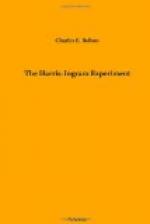Leo back again in Rome was in an ecstasy of joy. Here Greece had laid at the feet of Rome her conqueror, the accumulated art treasures of ages. Here Leo could have keenest delight, where he moved among the noblest examples of antique sculpture, which filled the galleries and chambers of the Vatican and Capitol. Most of the night he lay awake, planning how he could in so short a time exhibit to his American friends Rome and her wealth of art. At breakfast he said, “A whole day is needed to inspect the Forum Romanum, a day each, for the Capitoline Hill, the Appian Way, and many other historic localities in this seven-hilled city.”
Leo, acting as guide, took his party to the Pincian Hill near the northern wall, a fashionable resort with fine boulevards and frequent band music. From the summit, he pointed out the yellow Tiber, which winds for seventeen miles to the sea. The larger part of modern Rome lies on the left bank of the Tiber, and covers three historic hills. Towering above the tops of the buildings are the domes and spires of nearly four hundred churches of which the dome of St. Peter’s is the most imposing. In sight beyond are the Capitol, the ruins of the Colosseum, and ancient tombs along the Appian Way. To the west on the Palatine Hill are the ruins of the palace of the Caesars, and outside the walls, on the broad Campagna, are the remains of several aqueducts converging on the city, some of which, restored, are in use to-day.
The day’s ride included a visit to Agrippa’s Pantheon, now denuded of its bronze roofing and marble exterior. A circular opening in the huge dome admits both light and rain. Leo standing with Lucille by the tomb of Raphael in one of the recesses, for a moment was silent. Then he said, “Lucille, it is impossible to fully appreciate the many and beautiful works of this ‘prince of painters.’ He was born on Good Friday, 1483, and lived exactly thirty-seven years. He was of slight build, sallow, and had brown eyes. Over nine hundred prints of his works are known. Besides his works in fresco at the Vatican, for a time he had charge of the construction of St. Peter’s, and he also painted masterpieces now at Bologna, Dresden, Madrid, Hampton Court, and executed numerous commissions for Leo X.; and Madonnas, holy families, portraits, etc., for others. Raphael stands unrivaled, chiefly in his power to portray lofty sentiments which persons of all nationalities can feel, but few can describe. He also excelled in invention, composition, simplicity and grandeur. For moral force in allegory and history, and for fidelity in portrait, Raphael was unsurpassed. His last and most celebrated oil picture, the transfiguration, unfinished, stood at his head as his body lay in state.”
Colonel Harris was interested in the restored Triumphal Arch of Titus erected to commemorate the defeat of the Jews A.D. 70, also in the beautiful Arch to Severus. At the end of the Rostra, or Orators’ Tribune was the Umbilicus Urbis Romae, or ideal center of Rome and the Roman Empire. True it was that all roads led to Rome. Leo and Lucille visited by moonlight the ruins of the great Colosseum, and the lights and shadows in the huge old stone and brick amphitheater, made it look all the more imposing and picturesque.




